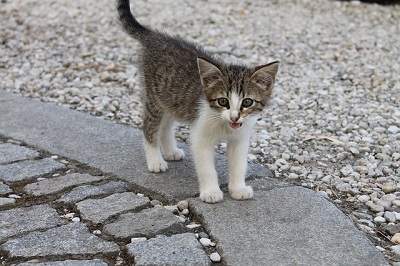What to Do If Stray Cat Appears on a Doorstep?
What to Do If Stray Cat Appears on a Doorstep?
Many of us have experienced this situation at least once in our lives. A stray cat somehow appears in our neighborhood or our doorstep, looking for food and shelter. But, what should we do? Should we feed her? Or, if we feed her, are we automatically responsible for the cat? According to many cat owners, many cats are missing because someone in a neighborhood feeds them. Frequently, we heard the news that after a cat disappeared, she was found two streets away or a few blocks below her home. That scenario is very common. A cat appears on our front porch and we immediately start feeding it without giving it much thought. For that reason, owners of missing cats appeal not to feed a cat until we are sure that a cat is a hundred percent feral. The best way to determine whether a cat is feral or not is to put a collar with a note and wait. If no one calls us, the cat is almost definitely feral one. If it is the case, we may feed a cat. According to feline experts, when we start feeding a cat, we become responsible for her. That does not mean we should adopt her if we cannot. But, we should bring her to a vet and call a shelter. Sometimes, there is someone in our surroundings who wants to adopt a cat. But, the process of taming a stray cat should be gradual and carefully planned. To find out more about what to do if a stray cat appears on a doorstep, the article “How to Handle a Stray Cat” gives us the following advice.
What to Do If Stray Cat Appears on a Doorstep?
Try to approach the stray. If you think the cat is a stray, approach slowly while speaking in a soft voice. If the cat acts skittish, try bending down to its level. Hold out your hand and call it with a sweet voice. If that doesn’t do it, return to the area later with a strong-smelling food, like tuna or dried liver.[1]
Try different tones or pitches, as some cats respond better to a higher or lower voice, or even ‘meow’ sounds.
Don’t get too close if the cat seems tense or nervous. If the cat feels cornered, it may bite or scratch.…
Provide shelter, water, and catnip for a potential stray cat. This may help to keep a lost cat near you until you can assist it. Place the food outdoors very late at night, in a small space that a cat could access but a larger animal could not.
In sub-zero temperatures, oil from a tin of sardines poured over kibble works well.
Do not leave food out until you suspect you have a stray, since this may just attract wildlife or feed other people’s pets (who may be on controlled diets).
…
Consider contacting a professional. If you cannot approach the cat, you could ask Animal Control or a local animal shelter to capture it. Find out their policies before you make the call, especially if the cat does not have tags. Many shelters euthanize cats that do not seem adoptable. Others offer a more humane trap-neuter-release (TNR) program, so the cat returns outside but doesn’t grow the feral cat population.
Shelters generally offer a better chance at a good life for strays than they find on the streets. In a shelter, the cat will not die of starvation, injuries, or exposure.
Many wonderful pets were stray cats once. It is up to us to decide whether we want to adopt a stray cat or not. Sometimes, a stray cat is easy to tame. Cat’s age and temperament determine how easy or difficult will be the process of its conversion to a cute pet. But each cat deserves a chance. And many owners claim their lovely pets was stray cats once. They believe that a cat has not appeared on their doorstep by chance. They also believe their encounter is somehow predetermined and they need this cute little friend to enrich their lives.










